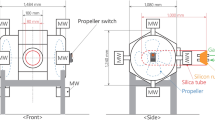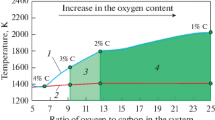Abstract
Nitroaromatic compounds are widely used in the industry. They are most often resistant to microbial degradation, mutagenic and carcinogenic. As a consequence, reduction of nitroaromatic compounds into less toxic and biodegradable products has been studied using Fe0. Here, we tested iron-rich waste from electric furnace dust to convert nitrobenzene into aniline. Thermal reduction of electric furnace dust under hydrogen at 500 °C gave a material with about 56 % Fe0 and 21 % FeO. This material allowed to decrease 86 % of nitrobenzene during the conversion of nitrobenzene into aniline. In conclusion, electric arc furnace dust can be transformed into an efficient reducing reagent.



Similar content being viewed by others
References
Adhikari R, Sarkar A, Limaye MV et al (2012) Variation and sign change of magnetostrictive strain as a function of Ni concentration in Ni-substituted ZnFe2O4 sintered nanoparticles. J Appl Phys 111:073903-1–073903-7. doi:10.1063/1.3699193
Agrawal A, Tratnyek PG (1996) Reduction of nitro aromatic compounds by zero-valent iron metal. Environ Sci Technol 30:153–160. doi:10.1021/es950211h
Brehm FA, Graffitti DF, Moraes CAM, Vilela ACF (2002) Desenvolvimento de um método para digestão de pós de aciaria elétrica com vistas à caracterização química do resíduo. Congresso em ciência de materiais do Mercosul, Anais do 1o Sulmat, Joinville, SC, pp 448–457
Gillham RW, O’Hannesin SF (1994) Enhanced degradation of halogenated aliphatics by zero-valent iron. Ground Water 32:958–967. doi:10.1111/j.1745-6584.1994.tb00935.x
Köseoğlu Y, Baykal A, Toprak MS et al (2008) Synthesis and characterization of ZnFe2O4 magnetic nanoparticles via a PEG-assisted route. J Alloys Compd 462:209–213. doi:10.1016/j.jallcom.2007.07.121
Li YH, Kouh T, Shim I-B, Kim CS (2012) Investigation of cation distribution in single crystalline Fe3−xMnxO4 microspheres based on Mössbauer spectroscopy. J Appl Phys 111:07B544-1–07B544-3. doi:10.1063/1.3687007
Luan F, Xie L, Sheng J et al (2012) Reduction of nitrobenzene by steel convert slag with Fe(II) system: the role of calcium in steel slag. J Hazard Mater 217–218:416–421. doi:10.1016/j.jhazmat.2012.03.047
Machado JGMS, Brehm FA, Moraes CAM et al (2006) Chemical, physical, structural and morphological characterization of the electric arc furnace dust. J Hazard Mater 136:953–960. doi:10.1016/j.jhazmat.2006.01.044
Maslehuddin M, Awan FR, Shameem M et al (2011) Effect of electric arc furnace dust on the properties of OPC and blended cement concretes. Constr Build Mater 25:308–312. doi:10.1016/j.conbuildmat.2010.06.024
Mecozzi R, Di Palma L, Pilone D, Cerboni L (2006) Use of EAF dust as heterogeneous catalyst in Fenton oxidation of PCP contaminated wastewaters. J Hazard Mater 137:886–892. doi:10.1016/j.jhazmat.2006.03.002
Raja P, Bozzi A, Jardim WF et al (2005) Reductive/oxidative treatment with superior performance relative to oxidative treatment during the degradation of 4-chlorophenol. Appl Catal B Environ 59:249–257. doi:10.1016/j.apcatb.2005.02.014
Schwarzbauer J, Dsikowitzky L (2014) Industrial organic contaminants: identification, toxicity and fate in the environment. Environ Chem Lett 12:371–386. doi:10.1007/s10311-014-0467-1
Sikalidis C, Mitrakas M (2006) Utilization of electric arc furnace dust as raw material for the production of ceramic and concrete building products. J Environ Sci Health A Tox Hazard Subst Environ Eng 41:1943–1954. doi:10.1080/10934520600779240
UNEP (2012) 21 issues for the 21st Century: result of the UNEP Foresight process on emerging environmental issues. In: Alcamo J, Leonard SA (eds) United Nations Environment Programme (UNEP), Nairobi, Kenya
Zamora PP, de Souza CRL (2005) Degradação de corantes reativos pelo sistema ferro metálico/peróxido de hidrogênio. Quim Nova 28:226–228
Zamora PP, Cavalotti LFR, Rodrigues MB, De Paiva TCB (2009) Degradação de espécies nitroaromáticas e remediação de efluentes da indústria de explosivos, utilizando-se processos redutivos-oxidativos fundamentados no uso de ferro metálico. Quim Nova 32:1504–1508. doi:10.1590/S0100-40422009000600027
Zhang W, Chen L, Chen H, Xia S-Q (2007) The effect of Fe0/Fe2+/Fe3+ on nitrobenzene degradation in the anaerobic sludge. J Hazard Mater 143:57–64. doi:10.1016/j.jhazmat.2006.08.061
Acknowledgments
The authors are grateful to FAPEMIG, CNPQ and CAPES.
Author information
Authors and Affiliations
Corresponding author
Rights and permissions
About this article
Cite this article
de Paula, L.N., dos Reis Giusto, L.A., Ardisson, J.D. et al. Efficient reduction of nitrobenzene into aniline using Fe-rich waste from electric furnace dust. Environ Chem Lett 13, 347–351 (2015). https://doi.org/10.1007/s10311-015-0510-x
Received:
Accepted:
Published:
Issue Date:
DOI: https://doi.org/10.1007/s10311-015-0510-x




